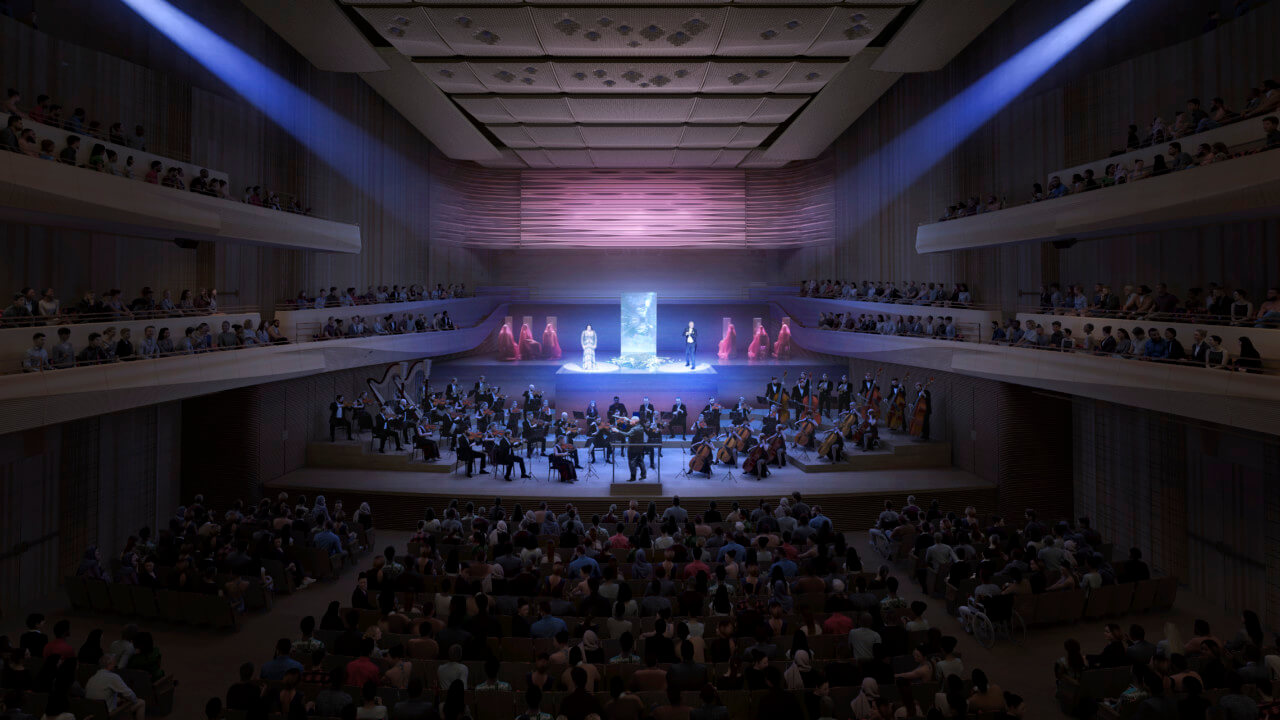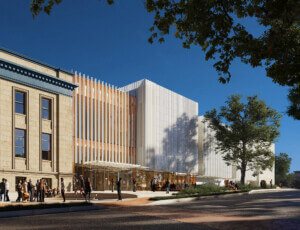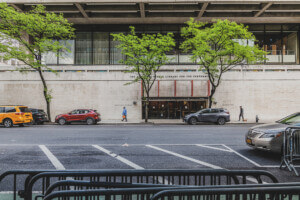Designed to be a modern acropolis, Lincoln Center has long been a mainstay of erudition plagued, despite its all-star cast of architects, by structural challenges, with Philharmonic Hall/Avery Fisher Hall/David Geffen Hall chief among them. Max Abramovitz’s original design has been consistently criticized for acoustic issues and “dead spots” since its 1962 unveiling. A ’70s renovation (Avery Fisher era) purported to right that wrong, to no avail. The material of choice at that time, a soft and porous stone—sourced exclusively from the storied Bagni di Tivoli quarry east of Rome—also makes the near-constant replacement of cracked, damaged, or weakened cladding elements laborious, expensive, and inefficient by any and all sustainability standards.
These failings, as we see them today, are part of the original Abramovitz scheme. While the entire Lincoln Center complex has resisted landmarking, the iconic institution of NYC culture (however problematic) has been conservative in its renovation and redesign efforts, which border on preservation-level practices. Keeping close to the original 1962 plans means jumping through hoops to make materials, finishes, and maintenance choices that feel outdated to a more efficient and ecology-minded industry today. But this staged tradition means that visiting Lincoln Center feels like stepping back in time.
The renovation of what is now David Geffen Hall is two-pronged: Social and public spaces are under the direction of Tod Williams Billie Tsien Architects, while the design of the reimagined concert hall is orchestrated by Toronto-based firm Diamond Schmitt. While the entire hall is very much under construction, some dramatic changes are already apparent: “This is all designed to be New York’s new living room,” Billie Tsien told AN during a hard-hat tour. But an expensive one, with a listed price tag of $550 million.
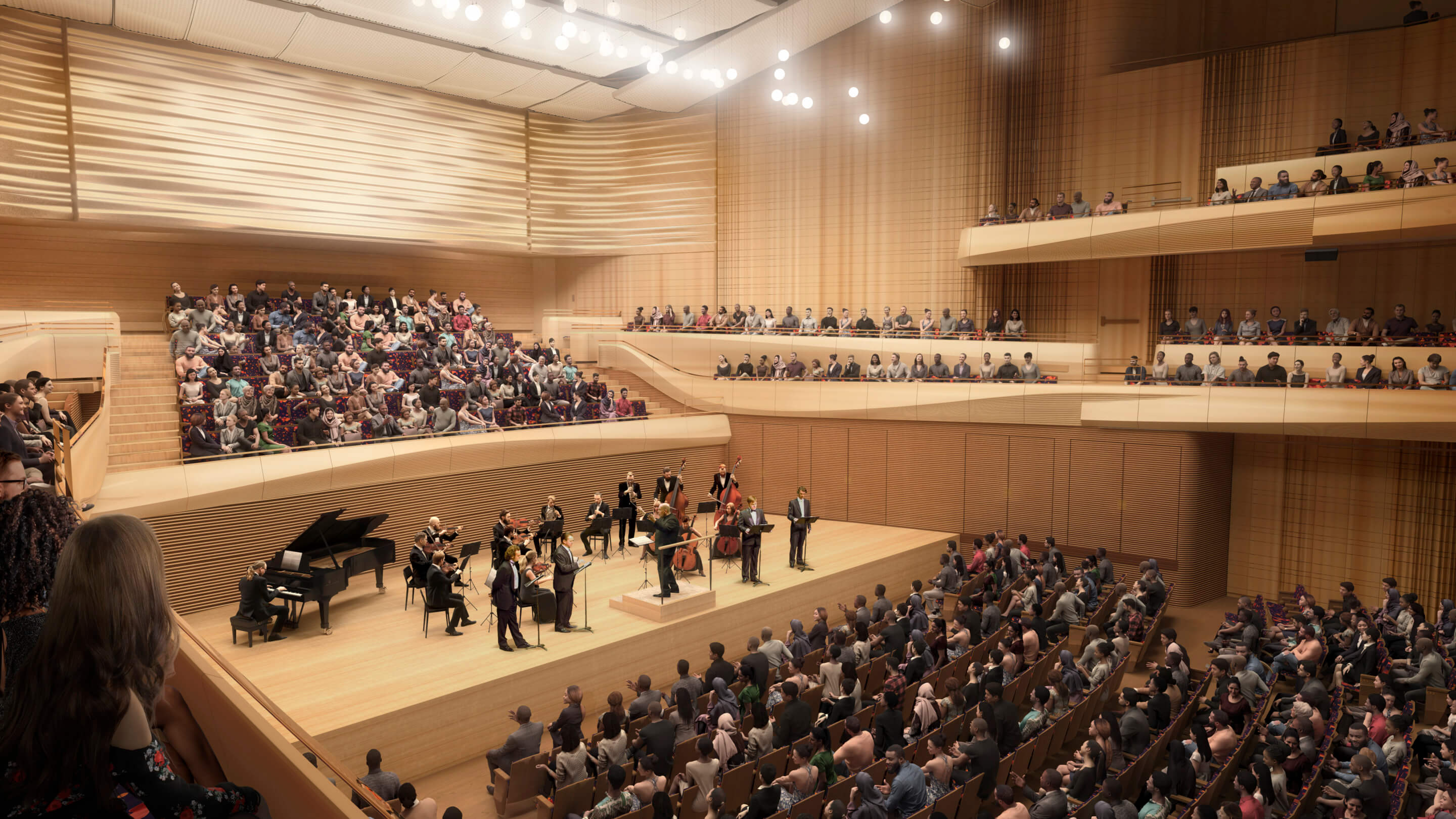
The hall is expected to open in October 2022, but that’s hard to believe when you’re standing in the lobby, hard hat on, and squinting through the sawdust as workers haul plywood or sit nearby on kneepads tiling floors. Upon completion, though, you’ll enter Geffen Hall through a garage-style rolling door that adds an indoor-outdoor feel to the entire space. Previously hidden structural columns take center stage now, their eccentric oblong forms freshly painted white. A striking difference is how you’ll ascend to the mezzanine level: Circulation now leads to the wings of the hall and upward via compact stairs or generous elevators. The original front-of-house escalators have been completely removed, freeing up the entire lobby for uninhibited gathering.
The choice to move ascending circulation made sense not only for an increased lobby footprint but also as part of the renovation’s increased sensitivity to ADA (over) compliance. The new circulation also leads visitors toward the reprogrammed back of house spaces, which used to be off-limits private offices. As work continues to open up floor plans and remove suspended ceilings, the ground-floor spaces will soon overlook Broadway as sidewalk studios: The generous, original window frames allow passersby to glimpse rehearsals and small performances. In turn, the rooms are flexible in their wall positioning, lighting, and sound systems, so practicing artists can make a space either more intimate (including closing the curtains) or open for large-scale repertoire.
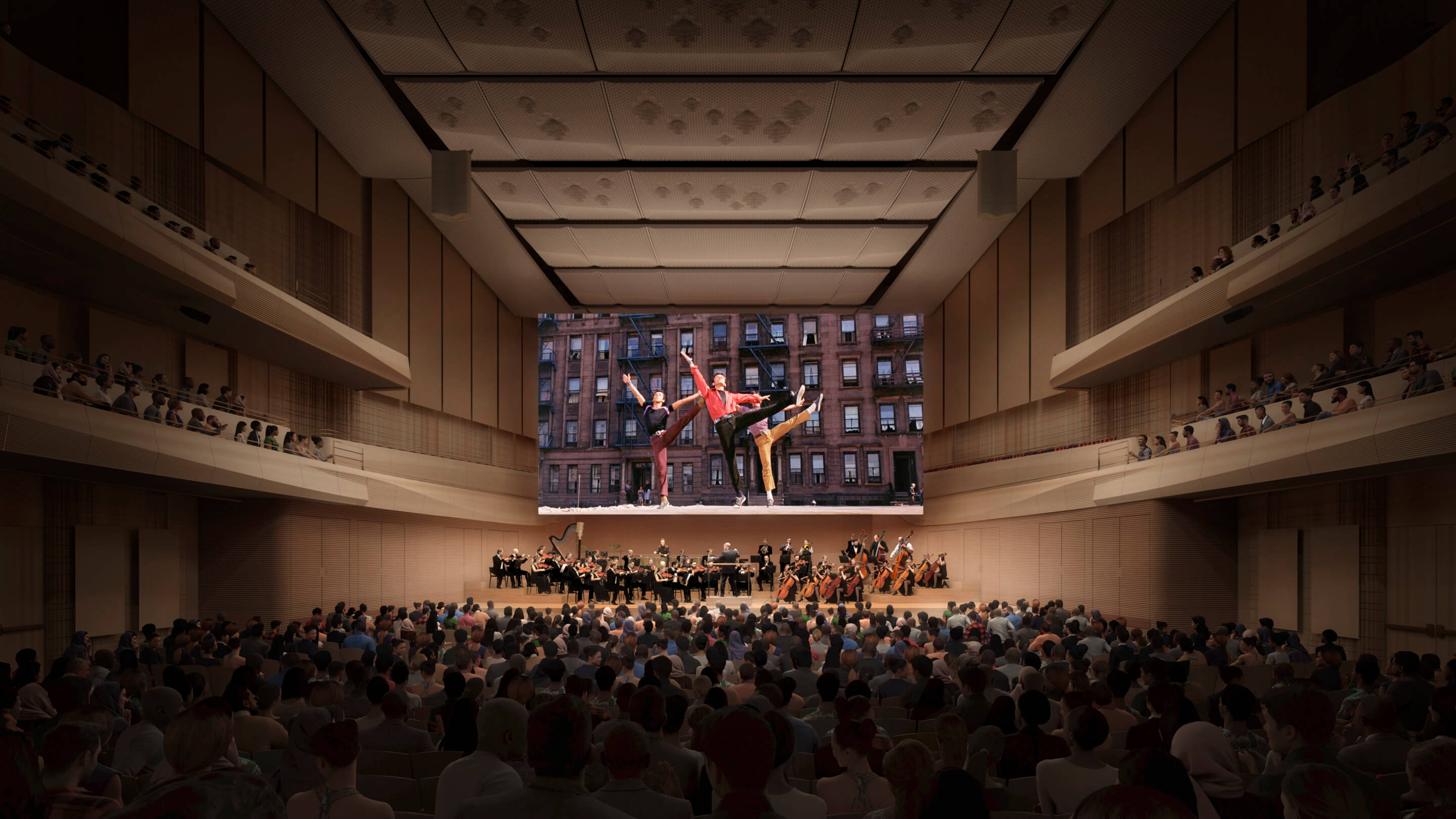
When you move upstairs via new subtle flanking staircases, the mezzanine feels expansive thanks to the removal of the two escalator chasms, but also because of intelligent detailing. The walls are now lined with textured acoustic paneling instead of the 1960s glass screen, and a sense of boundlessness stems from the newly uninterrupted flow of space out onto the accessible “front porch” outside. An additional level of bar and cafe space allows you to look down at it all: Organically curved balconies hang weightlessly overhead, suspended from cables barely two inches thick. Their undersides are already painted a deep indigo hue that stands out amid the ongoing construction. It’s a far cry from the opera’s prior dramatic reds, but the effect is fresh.
Inside the heart of the entire project, new auditorium seats are still sheathed in plastic wrap and floors are protected with thick brown paper, but already the centerpiece showcases its reimagined interior. The new hall resembles the weaving of a picnic basket: A specially sourced, fair-hued beechwood undulates away from the wall in a pattern resembling a sine wave; the pattern of bulges and concavities was engineered for acoustic feedback and integrated lighting. While raw material gives the void a stripped-down feel, another striking move was the removal of the pipe organ that once held center stage. Catering to modern performance, a new electronic organ has been installed. The console from which its sound originates can be moved anywhere on- or offstage, like DJ equipment. Gary McCluskie, principal architect with Diamond Schmitt, said that the work will mean “all can feel welcome and excited, no matter what music you have on your playlist.”
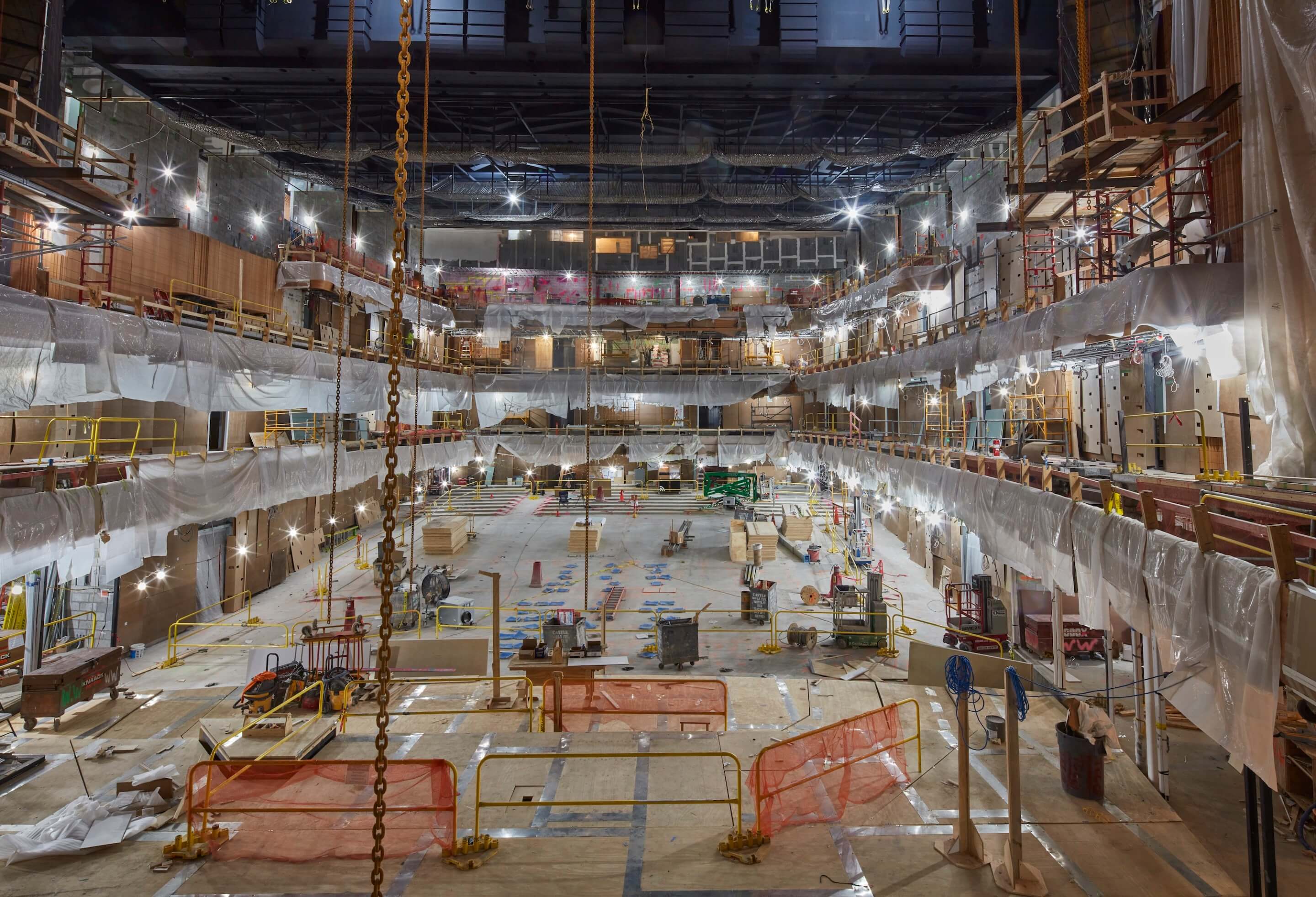
What’s also unexpected is the complete loss of the traditional proscenium stage. No walls or panels separate the sight space of the stage from the trappings of lighting, grip ladders, and microphones suspended from the ceiling. There will be no more velvet curtain falls here, as the audience now envelops the stage, somewhat like the Shakespearean theater in the round. First-tier rows flank the stage itself, and a small, steep seating area appears behind the stage, setting up a 360-degree panorama.
Some of the perennial acoustic issues with Avery Fisher Hall stemmed from the fact that there were too many seats in the original theater. To fix this, McCluskie described a design process “like repacking a suitcase: Everything had to be taken out in order to find the most efficient solution.” Diamond Schmitt not only increased the rake of the floor (from 4.9 to 7.5 degrees) but also removed seats: The stage is 25 feet closer to the entrance, and only 2,200 of the original 2,738 seats remain. The audience is smaller, yes, but its sense of intimacy with and proximity to the performers is a definite improvement. A sold-out show at David Geffen Hall will sell fewer tickets but hopefully recoup its reputation.
Emily Conklin is a writer-editor-researcher and architecture historian. Her work centers lineages of design and spatial imagination through prose. Her writing has appeared in the New York Review of Architecture, Surface, and Platform Space, among other publications, and on her Substack Design Trich.










